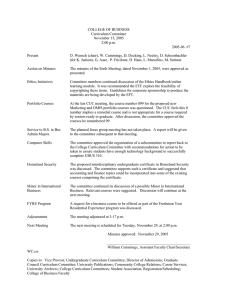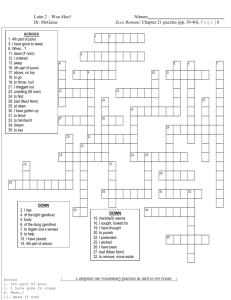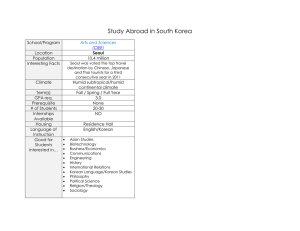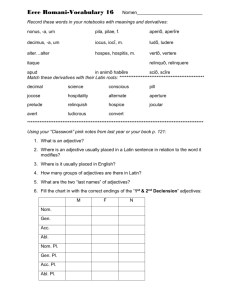Case Stacking and the Chain Condition
advertisement
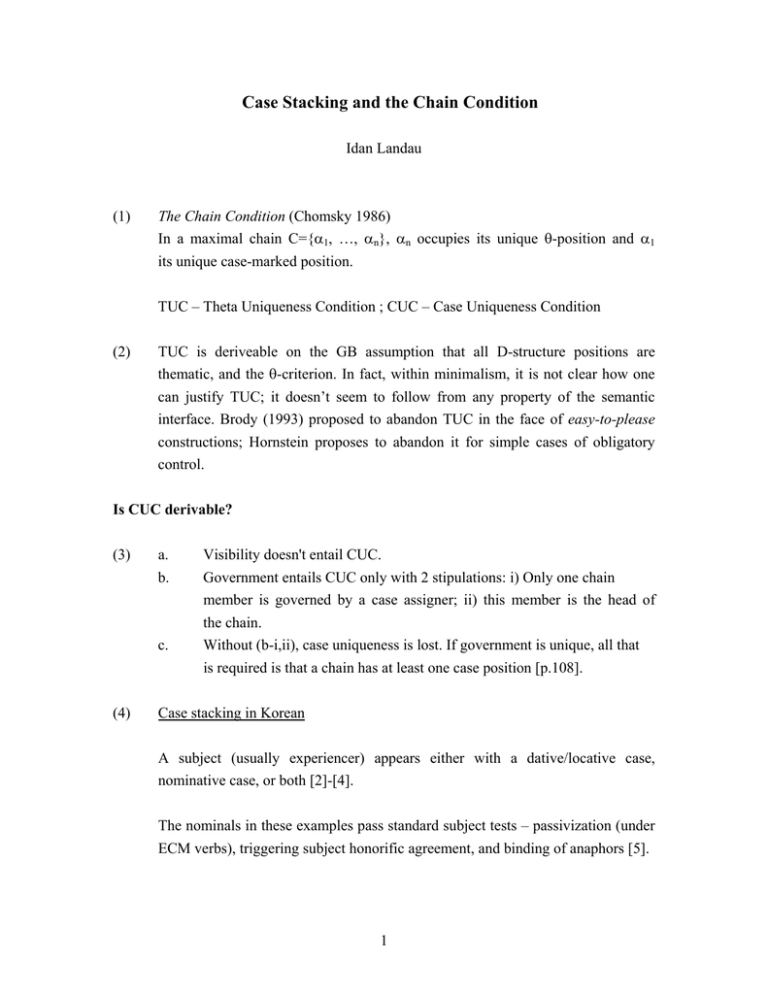
Case Stacking and the Chain Condition
Idan Landau
(1) The Chain Condition (Chomsky 1986)
In a maximal chain C={α1, …, αn}, αn occupies its unique θ-position and α1
its unique case-marked position.
TUC – Theta Uniqueness Condition ; CUC – Case Uniqueness Condition
(2) TUC is deriveable on the GB assumption that all D-structure positions are
thematic, and the θ-criterion. In fact, within minimalism, it is not clear how one
can justify TUC; it doesn’t seem to follow from any property of the semantic
interface. Brody (1993) proposed to abandon TUC in the face of easy-to-please
constructions; Hornstein proposes to abandon it for simple cases of obligatory
control.
Is CUC derivable?
(3)
a.
b.
c.
(4) Visibility doesn't entail CUC.
Government entails CUC only with 2 stipulations: i) Only one chain
member is governed by a case assigner; ii) this member is the head of
the chain.
Without (b-i,ii), case uniqueness is lost. If government is unique, all that
is required is that a chain has at least one case position [p.108].
Case stacking in Korean
A subject (usually experiencer) appears either with a dative/locative case,
nominative case, or both [2]-[4].
The nominals in these examples pass standard subject tests – passivization (under
ECM verbs), triggering subject honorific agreement, and binding of anaphors [5].
1
Note: Yoon notes [fn. 6, 8] that the stacked NP is interpreted as a focus, which is
why it is preferred with the marker –man ‘only’. He assumes that NOM can be
assigned either in [Spec,VP] or in [Spec,IP]; the latter position gives rise to
exhaustive focus. One may raise the doubt of a misanalysis. Schütze (1997) in
fact argued that the Nominative (and Accusative) suffix is ambiguous between a
case marker and a focus marker. In stacked nominals, it is only a focus marker
(so, strictly speaking, case stacking doesn’t exist).
(5) Following Belletti & Rizzi (1988), Yoon adopts an unaccusative analysis of
psych constructions [6]. The experiencer/locative is generated as a VP-internal
argument (higher than the theme). It is assigned DAT/LOC in situ, and then raises
to [Spec,IP], where it is assigned NOM; The CUC is violated.
Note: Nothing in the proposal hinges on the unaccusative analysis of psych verbs.
Even if the experiencer/locative NP is generated as an external argument in [Spec,vP], it could be assigned DAT/LOC in that position. Problem 1: How can NOM be suppressed, as in [2b]-[4b]?
Answer [fn. 8]: Structural case markers can be optionally dropped. Problem 2: How can DAT/LOC be suppressed, as in [2c]-[4c]?
Answer [fn. 8]: The experiencer/locative is optionally selected as an NP rather than a PP. Huh?
(6) Case stacking in Cuzco Quechua:
A subject of a nominalized complement bears GEN. Raising-to-Object stacks
ACC on top of GEN [8].
Finite ECM/RtO
In several languages, an NP raises from the subject position of a finite complement clause
to the matrix object position. The lower position is is typically assigned NOM, the higher
one ACC. The nominal surfaces with only one case marker (no visible stacking), but
given simple assumptions, must be assumed to be doubly case-marked.
2
Examples: [9]-[12]. Notice that RtO affects word-order; sometimes it even leaves a
resumptive pronoun [14].
(7) Analysis of finite ECM: [Spec,CP] is an A-position, to which matrix ACC is
assigned [15]. Due to locality (Subjacency), [Spec,CP] can’t be skipped; due
to the ban on improper movement, it can’t be an A-bar position.
Note: We still lack an account of why stacking of NOM-ACC or ABS-ERG is
not attested. The answer will be morphological, not syntactic.
(8) CUC violations in A-bar movement [16,17].
(9)
Possible alternatives to multiple case assignment
a. b. c. (10)
(11)
Optional NOM assignment in finite ECM (governed by economy).
There are two chains with unique cases, not a single chain with two cases.
CUC only applies to structural case (so stacking inherent+structural is OK).
A
gainst (9a)
[p.123, top]
a. In case stacking, “the optionality must have been suspended”. Note: Stacking is optional, what’s the problem? b. If the optionality is due to economy, Last Resort predicts that the realized
case in an A-chain must always be the one assigned to the head position. But
in fact, in Farsi and Tongan the case of the tail position is realized (on the
head position).
Against (9b)
(9b) entails control, not raising. But thematic independence refutes that. [19]
Against (9c) – a morphological filter on stacking
(12)
a .
Korean: √ Inherent+Structural, *Structural+Structural
3
[28]
b.
Cuzco Quechua: Structural+Structural is possible.
[8]
Explanation: There is only one morphological slot for structural case in Korean.
Arguments: i) Other affixes compete for this slot [29,30].
ii) Honorific NOM can stack with simple NOM [31], since the former
occupies the slot of Inherent case (even though it’s structural).
Case resolution strategies
(13)
I-case must be realized.
Icelandic [33]: S-case is suppressed ; Korean [34]: S-case cooccurs with I-case.
Yoon claims that the difference reflects a difference in the number of available
case-slots; obviously, this claim requires independent support.
A potential counterexample [35] is dismissed; it is not DAT which is suppressed,
but rather the psych predicate c-selects an NP instead of a PP [fn. 8] (presumably, it
is P that assigns DAT, not V). But if DAT is tied to the θ-role experiencer, it should
be ineliminable. And why can't Icelandic verbs c-select an NP in [33]?
Note: Yoon's analysis of Icelandic quirky subjects assumes that they always bear
two cases, from which morphology chooses to spell out one.
(14)
Competition between two S-cases
Korean: The higher S-case wins.
Argument: Embedded NOM subjects can corefer with the matrix subject, but
ECM ACC subjects cannot [36]. Yoon concludes that the former occupy a lower
position, hence the lower case (NOM) can only be realized in the lower position
of the chain.
Note: Actually, [36] doesn’t show what it’s supposed to – namely, that when two
S-cases compete in Korean, the higher one wins. For this to be shown, Yoon must
demonstrate that NOM can’t be realized in the high position of the A-chain in
4
RtO. But all that [36a] shows is that NOM can be realized in the low position
(presumably, the high position would be ruled out by condition B).
(15)
Preservation of lower S-case:
Farsi [37]; the evidence is very indirect. Yoon assumes that NOM is assigned in
the matrix clause even in the absence of agreement. But it’s equally plausible that
NOM is not assigned in the matrix, so no case resolution is needed.
Tongan [38]; Again, it’s possible that ABS is not assigned in the matrix clause.
Moreover, if ERG is inherent case (as some have suggested), this falls under the
the I-case vs. S-case scenario.
Turkish [39]; The lower case can be “overwritten” only if it’s morphologically
null.
(16)
Conclusion: Yoon concludes that there are no UG principles of case resolution
when two S-cases compete on the same NP. But we’ve seen that the evidence for
preservation of the low S-case in (15) is very weak. In fact, the evidence for “high
S-case wins” is much stronger, and could explain all the facts, if we assume that
one S-case isn’t assigned in the cases of Farsi/Tongan/Turkish.
(17)
Two I-cases [40]
Naïvely, that should violate uniqueness of θ-role. Yoon allows instead "multiple
θ-relations", or treating the composite case marker as a single marker.
(18)
Revised Chain Condition (RCC) [41]
C={α1, …, αn} is an A-chain iff C is the maximal sequence that each member of
C bears the same index and:
(i) αn has a unique θ-role.
(ii) For αi, 1 ≤ i ≤ n, the Case of αI is determined by a unique (Case-)governor.
RCC and CUC yield the same predictions for [42b-e]. They only differ on [42a],
ruled out by CUC but allowed by RCC. The evidence section 2 favors the latter.
5
Note: The RCC preserves the uniqueness of government per position. But if the
same head can assign two cases, as in [42e], double case-marking is possible
without movement; see [54, 55].
(19)
(20) RCC predictions
a. Stacking [48]: There is indirect evidence (from focus, fn. 8) that the
DAT-NOM DP moved (string-vacuous), so the two cases come from
two governors.
b. Finite ECM: If the ECM subject moves overtly to the embedded
[Spec,CP], then its ACC and NOM are assigned by different governors.
Bottom line of section 3.2.3
In a configuration: [XP X0 [YP ZP [Y’ Y0 WP ]]], both Y (the internal head) and X
(the external head) are potential governors of the specifier ZP. Yoon defines
head-government in such a way that the following result holds: Y governs ZP iff
it assigns some feature to it (e.g., case); otherwise, X governs ZP.
(21) A contrast between Korean & Cuzco [51]
While ECM subjects in verbal complements in Korean get ACC or NOM (see
[9a]), in nominalized complements they get GEN or NOM but not ACC.
However, in Cuzco Quechua they can get ACC, as well as GEN.
Explanation: Korean nominalized C assigns GEN, blocking external government
by ACC-assigning V [52]. In Cuzco, GEN is assigned by I, so [Spec,CP] is visible
to external government [53]. There's also morphological evidence for this. A
cogent argument!
Note: The Korean data appear to support the standard CUC (the lower GEN is
preserved, the higher ACC isn’t assigned); but a closer analysis reveals that the
higher ACC had no chance of being assigned, due to lack of government. The
case is different, of course, with verbal complements, whose subject is visible to
external government (getting ACC).
6
(22) Apparent evidence for CUC
[56,57]: Yoon claims that they violate other principles as well, hence can't be
taken as evidence for CUC. But what "other principles"? Condition A is no longer
relevant for NP-traces, the ECP is satisfied in both.
(23) [58a,59a] – Yoon admits a problem: They are allowed by RCC, excluded by
CUC.
a. b.
It seems to/strikes John that Bill is a jerk.
* John1 seems to/strikes t1 that Bill is a jerk.
Yoon's account: Associate CPs have features to check, and in (a) they do it by
covert LF raising to the expletive it. In (b) the checking position is taken by John.
Note: If CPs do have features, then presumably they can be checked by I that had
already checked against it, an expletive with 3rdSg. But then why should it be
impossible when the first checking is against John?
[62,63] show that [58b,59b] are OK in Korean.
Notes: Two parametric differences are needed to allow that: (i) Korean has no
expletives; (ii) Korean CPs have no features to check (to allow [62c]). This
cooccurence seems accidental. Notice also that the Minimal Link Condition
should block [62c], given [62b].
Prediction: [62c] should be impossible with case stacking on John.
(24) Making RCC compatible with minimalism
The problem: If overt movement must be self-serving (strong Greed), once a case
position has been reached, no overt movement can take place from it, since the
DP’s only need – case checking – has been fulfilled (Last Resort).
7
Yoon (following Lasnik): "Enlightened Greed" allows overt movement triggered
by the target. Importantly, once strong Greed is abandoned, CUC does not follow
anymore and multiple case is allowed.
Note: This is in fact the modern view, which rejected Greed altogether. Still,
multiple case is ruled out by Chomsky as case checking makes DPs "invisible" to
further attraction. Chomsky discussed structural case – perhaps inherent case is
constantly visible (allowing the raising of Korean DAT NPs and Icelandic quirks).
(25)
Is case stacking optional? [64]
True optionality is problematic in economy-based grammar. Yoon argues that the
choice between DAT or DAT-NOM is free since they proceed from different
numerations (different case affixes).
(26)
Summary
Multistratal derivational theories lead us to expect that multi-membered chains will
have properties that set them apart from single-membered chains. Multiple case is
exactly such a property. (Note: This is compromised by [42e, 54, 55]).
8
